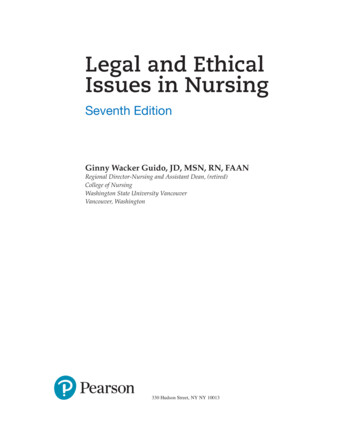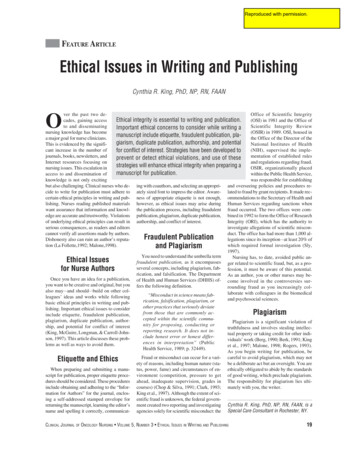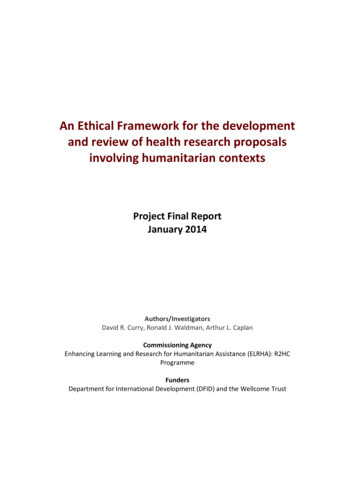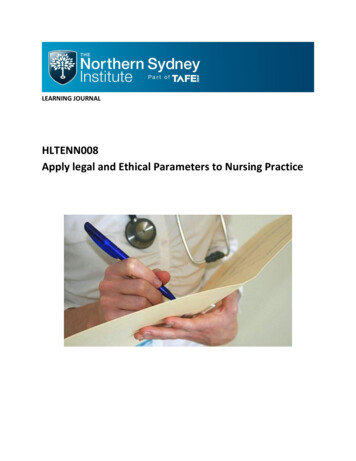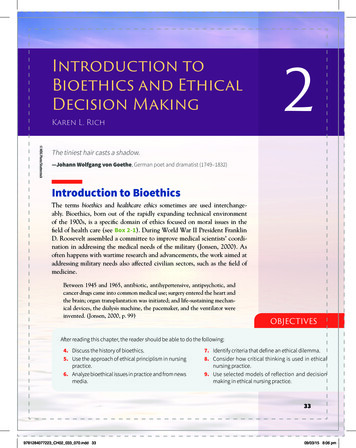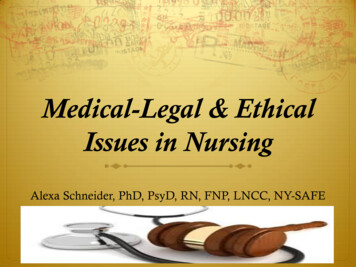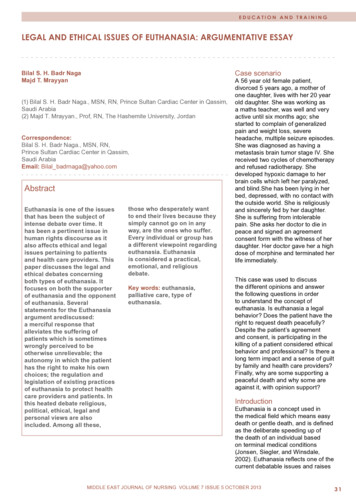
Transcription
EDUCATION AND TRAININGLegal and Ethical Issues of Euthanasia: Argumentative EssayCase scenarioBilal S. H. Badr NagaMajd T. Mrayyan(1) Bilal S. H. Badr Naga., MSN, RN, Prince Sultan Cardiac Center in Qassim,Saudi Arabia(2) Majd T. Mrayyan., Prof, RN, The Hashemite University, JordanCorrespondence:Bilal S. H. Badr Naga., MSN, RN,Prince Sultan Cardiac Center in Qassim,Saudi ArabiaEmail: Bilal badrnaga@yahoo.comAbstractEuthanasia is one of the issuesthat has been the subject ofintense debate over time. Ithas been a pertinent issue inhuman rights discourse as italso affects ethical and legalissues pertaining to patientsand health care providers. Thispaper discusses the legal andethical debates concerningboth types of euthanasia. Itfocuses on both the supporterof euthanasia and the opponentof euthanasia. Severalstatements for the Euthanasiaargument arediscussed:a merciful response thatalleviates the suffering ofpatients which is sometimeswrongly perceived to beotherwise unrelievable; theautonomy in which the patienthas the right to make his ownchoices; the regulation andlegislation of existing practicesof euthanasia to protect healthcare providers and patients. Inthis heated debate religious,political, ethical, legal andpersonal views are alsoincluded. Among all these,those who desperately wantto end their lives because theysimply cannot go on in anyway, are the ones who suffer.Every individual or group hasa different viewpoint regardingeuthanasia. Euthanasiais considered a practical,emotional, and religiousdebate.Key words: euthanasia,palliative care, type ofeuthanasia.A 56 year old female patient,divorced 5 years ago, a mother ofone daughter, lives with her 20 yearold daughter. She was working asa maths teacher, was well and veryactive until six months ago; shestarted to complain of generalizedpain and weight loss, severeheadache, multiple seizure episodes.She was diagnosed as having ametastasis brain tumor stage IV. Shereceived two cycles of chemotherapyand refused radiotherapy. Shedeveloped hypoxic damage to herbrain cells which left her paralyzed,and blind.She has been lying in herbed, depressed, with no contact withthe outside world. She is religiouslyand sincerely fed by her daughter.She is suffering from intolerablepain. She asks her doctor to die inpeace and signed an agreementconsent form with the witness of herdaughter. Her doctor gave her a highdose of morphine and terminated herlife immediately.This case was used to discussthe different opinions and answerthe following questions in orderto understand the concept ofeuthanasia. Is euthanasia a legalbehavior? Does the patient have theright to request death peacefully?Despite the patient’s agreementand consent, is participating in thekilling of a patient considered ethicalbehavior and professional? Is there along term impact and a sense of guiltby family and health care providers?Finally, why are some supporting apeaceful death and why some areagainst it, with opinion support?IntroductionEuthanasia is a concept used inthe medical field which means easydeath or gentle death, and is definedas the deliberate speeding up ofthe death of an individual basedon terminal medical conditions(Jonsen, Siegler, and Winsdale,2002). Euthanasia reflects one of thecurrent debatable issues and raisesMIDDLEEAST JOURNALOF NURSINGVOLUME7 ISSUE5 OCTOBER 2013MIDDLEJULYMI D D L EASTE E AJOURNALS T J O U OFR N NURSINGAL OF NU R 2012,S I N GVOLUME J U L6YISSUE2004931
EDUCATION AND TRAININGmany questions that need to beanswered.Health care professionals, includingoncology nurses, frequentlyencounter ethical issues whencaring for end of life patients andhave to make a decision and choosebetween difficult or unacceptableoptions and are frequently obligatedto use their own moral reasoning tosolve these ethical issues (Elis &Hartley, 2007).In today’s world, in spite oftechnological and scientific progress,especially in the field of laws andregulations related to humanhealth there is still ambiguity andcontroversy over the concept ofpeaceful death (euthanasia). Thus,this ethical dilemma may imposehealth care providers to legal andethical risk.The ethical and legal aspects of theconcept of euthanasia are still widelydebated in many countries of theworld. There are several opinionsbased on the principles of personalmorality and religious beliefs.Thus, scientists and researchersare still looking to reach a generalconsensus on this ethical dilemma.In Islamic countries there arediscussions and debates aboutwithholding or withdrawing thelife support therapies or allowinga patient at the end of the life tochoose peaceful death. Based onIslamic law, health care providersare not protected and have noimmunity in case of deciding to helppatients to die. Thus, according tothe Islamic point of view; it is notrecognized for a patient to have theright to die voluntarily because lifeis a divine trust and an opportunityto refine the spirit. Then, no one hasthe right to quit human life throughany form of interference with activeassistance.Some Muslim Clerics scholarsemphasized that life-savingequipment cannot be stoppedunless physicians are confident32of the inevitability of death and nohope (Zahedi, Ali Larijani, & Draper,2007).Therefore withholding or withdrawingtreatment of any patient is nevereasy and cannot be generalizedwithout taking into considerationthe cultural, social, and religiousfactors when making decisions. Theincidence of death as a result ofeuthanasia has been found to differbetween countries (OnwuteakaPhilipsen, Fisher, Cartwright,Deliens, Miccinesi, Norup, et al.2006; Ganz, Benbenishty, Hersch,Fischer, Gurman, &Sprung, 2006).In the Netherlands as an example ofa western country it is seen that ninepercent of all deaths in 1990 werea result of euthanasia (Remmelink,et al. 1991). Unfortunately, there isa lack of statistics on the incidenceof direct terminating of life byphysicians in the Kingdom of Jordanand no clear policy about euthanasiafor patients at the end of life stagewhether that is secondary to cancer,or to any other end stage illness.The advancement in medicaltechnology is bringing deathsinto hospitals where life, may beprolonged for a long time. Forexample, in Britain at any onetime there are about two thousandpeople who have spent more thansix months in a persistent vegetativestate from which they will neverrecover. Many dread the endlessindignity of such a fate. Worldwidethere is a need to address the issueof euthanasia in order to manageand support clients and staff whoare in a situation where a requestof death is in place. In Jordan, yet,there are no studies that discusseuthanasia, or end-of-life decisionsin any clinical setting.This paper aims to discusseuthanasia among different westerncountries and Islamic countries andfocus on the legal, religious, andsocial perspectives regarding thiscontroversial issue.This argument essay is attemptedto decrease and limit the argumentamong health care professionalsregarding euthanasia in orderto enhance clear decisions,communication and accountability.This paper is organized to discussand show viewpoints from bothsides of the arguments and isconcluded with the writer’s opinion.A case scenario was selected anddiscussed for better understandingof this issue of euthanasia.Definition and Background ofEuthanasiaThe definitions of euthanasia arenot enough to find a clear societyconsensus. In order to increasepublic support we need to keep cleardefinitions so we know what we’retalking about. Euthanasia is takenfrom the Greek ward euthanos,which means “good death.” Deathwith dignity and without suffering,but the question is, how do we goabout achieving this?Euthanasia is the active killingof a patient by a physician, onthe patient’s request and in thepatient’s interest (Tom and Arnold,1979). There are two types ofeuthanasia - passive and active.Passive euthanasia is definedas allowing a patient to die bywithholding treatment, whereasactive euthanasia is defined astaking measures to directly causea patient’s death. Another divisionof euthanasia is that it is voluntary,involuntary, and non voluntary.Voluntary euthanasia is when apatient gives his agreement whereasnon voluntary is when the agreementis unavailable because of a patient’scoma (Singer, 2011). Involuntaryeuthanasia occurs when euthanasiais performed on a person who isable to provide informed consent, butdoes not, either because they do notchoose to die, or because they werenot asked. Nurses may encountermany questions from patients andtheir families when counsellingthem about hastening the death of apatient (Gorman, 1999; Lewis, 2007).There are some statistics regardingmedical practitioners who support oroppose euthanasia (Appendix A).MIDDLE EASTJOURNAL OFNURSINGVOLUME7 ISSUE 5 OCTOBER2013NURSINGISSUEM I D D L E E AMIDDLES T J OEASTU R N JOURNALA L O F NOFURS I N G JULYD e2012,c e mVOLUMEber20609/ J a4n u a r y 2 0 1 0
EDUCATION AND TRAININGPhysician Assisted Suicide (PAS) isdefined as: ‘The situation where adoctor intentionally helps a personto commit suicide by providingdrugs for self-administration, at thatperson’s voluntary and competentrequest’ (Best, 2010). Accordingto Best, in PAS the doctor is notdoing the action but morally he isinvolved as the motive intentionand the outcome are the same.Thus, euthanasia and PAS are usedinterchangeably in this paper.Euthanasia WorldwideEuthanasia is a controversial issuein Australia. Although there aredifferent laws in Australia relatedto euthanasia, the legislations inmost States consider it as illegal.At first, it was legal by Rights of theTerminally Ill Act 1995, and then itwas overridden by the Australiangovernment. But an Australian Dr.Philip Nitschke helped three patientsto achieve euthanasia (Alexander,2010). In 2002 in Belgium theBelgian parliament passedlegislation for euthanasia (Adams &Nys, 2003).Smets and his colleagues (2010)conducted a survey and foundthat most deaths by euthanasiacompared with other deaths weremore often younger, male, cancerpatients and more often died intheir homes. In almost all cases,unbearable physical suffering fromuncontrolled pain, poor woundhealing, and poor social interactionswere reported.Canadian laws on living wills andpassive euthanasia are a legaldilemma. It is illegal to ‘aid andabet suicide’ under Section 241(b)of the Criminal Code of Canada,which states that this is an indictableoffence with a potential fourteenyear sentence if the appellant isfound guilty (Ministry of AttorneyGeneral, 2010). Also the Britishlaw has the same attitude towardeuthanasia by considering it asillegal by all means.In Indian laws, passive euthanasiais legal supported by the SupremeCourt for brain death patients, butany actions whatsoever to end thelife of a patient (active euthanasia)is illegal (Magnier, 2011). The samecase applies to Ireland. Activeeuthanasia is considered illegalwhile passive euthanasia is legal.The Israeli and Jewish laws considereuthanasia as illegal, but in somecases it can be accepted under theIsraeli law (Butcher, 2005; Brody,2009).Active euthanasia is illegal inmost of the United States. Whilevoluntary, passive euthanasia isconsidered legal; the patients havethe right to reject medical treatment.Italy witnesses a social and legalcrisis about a woman who had acar accident and she has beenunconscious since 1992.The Prime Minister Perleskonyrefused to endorse euthanasia forthis woman claiming that nobodyhas the right to end the life ofany human being. The SupremeCourt in Italy decided to end thiswoman’s life by euthanasia andthey stopped giving her food ordrink. And so the decision taken bythe Italian government breaks thesentence taken by the SupremeCourt according to the Italian law.It is obviously noticed that in thecountries which allow euthanasia,such as Holland, there has beenpoor palliative and hospice carewhereas in the countries whereeuthanasia is forbidden, they havedeveloped hospice care for thepatients who are suffering badly.The issue of euthanasia has beenraised in recent years in Islamiccountries due to the debate overspecific cases in which specificpatients or their families have askedhealth care professionals, judgesand religious people for a patient’sright to die with dignity in a numberof different ways (Bernard, 2000).In reality the issue did not enterinto open public debate as it has inthe USA and European countries.Despite this, the concept ofeuthanasia has mainly concentratedon physicians due to the nature oftheir roles.Turkey, as an Islamic country forbidseuthanasia strictly and considerssuch actions as a crime by theCriminal Law of Turkey (Karadeniz,Yanikkerem, Pirincci, Erdem, Esen,and Kitapcioglu, 2008). In Jordaneuthanasia is illegal even if informedconsent is taken from the patientor his family, thus it is considered acrime against human life and the onewho commits euthanasia whetheractively or passively will be punishedby the law as being an intentionalact.DiscussionRegarding Patient SufferingMany patients experience painand suffering when they are dying,that is true, and during my clinicalexperience I have seen manydying patients who at their endstage illness were in pain, and theymay be treated without dignity, orexperiencing spiritual disorders.But, we think this is an individualexperience.This is supposed notto happen, but it is still happeningand people are using this factor toconvince people for the legalizationof euthanasia. We must do betterand look for better solutions. Thereis another option, which explainswhy euthanasia is increasinglyunnecessary.In the Greek Orthodox Churcheuthanasia is not accepted in everytype, and there is no legal legislationor any action that helps patients tobe allowed euthanasia (Voultsos,Njau, and Vlachou, 2010). Keown,(2005) reported Buddhists’ point ofview and found that there are manydifferent opinions about euthanasiaand they justify it as to end thesufferings of a patient. However,there is no justification whatsoever toend the life of a human being underany circumstances.Moreover, in the teachings of theCatholic Roman Church euthanasiais a crime against life and God. Onthe other hand, Evangelical churchesand the Roman Catholics have thesame attitudes towards euthanasiawhich says that life is sacred.MIDDLEEAST JOURNALOF NURSINGVOLUME7 ISSUE5 OCTOBER 2013MIDDLEJULYMI D D L EASTE E AJOURNALS T J O U OFR N NURSINGAL OF NU R 2012,S I N GVOLUME J U L6YISSUE2004933
EDUCATION AND TRAININGAccording to the Hindu views,there are two points of view. Oneconsiders euthanasia as a goodaction; the other considers it asdisturbing the cycle of death andrebirth. Also, why are churches thatestablished the first hospices in the19thcentury and medical and nursingstudents now receiving training inpain control, because they believethat different types of pain respondto different treatments and this willhelp in caring of the dying.In general, suffering is not onlya medical problem but also anexistential problem that extendsbeyond physical pain. It isinfluenced by many factors such aspsychological, cultural and spiritualfactors and we can deal withphysical symptoms but the sufferingmay remain.Islam forbids all forms of selfkilling whatever the reason is forlife and death is in the hands ofAllah and nobody has the right toend this life bestowed by Allah andit is considered as a suicide. Thismeans that Islam is totally againsteuthanasia whether active or passiveand considers it a type of killing if itis committed by a different personand a suicide if it is committed bythe same person and both of themshould be punished and sent tohell in the other life. Thus Islamhas a clear cut attitude towardseuthanasia which is strictly forbiddenby all means because Islam and theprophet (the messenger of Allah)said that life belongs to Allah andHe is the only One who has theright to give or take it away withoutany exceptions. Accordingly, all theFatwa Councils in all the Arab andIslamic countries do not pass anylaw (Fatwa) considering it as legalunder any circumstances.In addition, the Islamic Code ofMedical Ethics, 1986 mentions thatthe concept of a life not worthyof living does not exist in Islam.Justification of taking life to escapesuffering is not acceptable in Islam.Prophet Mohammad taught: “Therewas a man in older times that hadan infliction that taxed his patience,34so he took a knife, cut his wristand bled to death. Upon this Godsaid: My subject hastened his end,I deny him paradise.” (Translationof Sahih Muslim, Book 35). Yusufal-Qaradawi, the chairman of theInternational Union for MuslimScholars (IUMS) mentioned that wecan say that the Islamic perspectiveis that life belongs to Allah. It is Hewho gives and takes away life. Nohuman can give or take it. Muslimsare against euthanasia. They believethat all human life is sacred becauseit is given by Allah, and that Allahchooses how long each person willlive (Fatwah Bank. 1996).Moreover, the religious communityin Islamic countries has discussedsome sensitive medical issues suchas definition of death, withholdingand withdrawing life sustainingmeasures, and its legality as earlyas 1983. The Permanent Committeefor Research and Fatwa issueda statement (Riyadh No. 6619;1983) that advanced life supportmeasures can be stopped if themedical team affirms that brainfunction has irreversibly ceased(Albar, 2004). The Islamic FIqh(comprehension) Academy; 3rdsession, 1986, Amman, Jordan,Resolution No. 5 concluded that aperson can be declared dead in oneof two conditions: (1) complete andirreversible cardiopulmonary arrestaffirmed by physicians. (2) Cessationof brain activity and affirmation byphysicians that this cessation isirreversible and that the brain hasentered the state of decomposition(OIC, 2003; Albar, 2004).Physician and Protection of LifeOne aspect of the euthanasia debatethat is often ignored is that it expectsdoctors to perform euthanasia. Oneof the main roles of physicians is togain a patient’s trust and therapeuticrelationship, and how does onemaintain this goal if the patient’sperception will change toward thephysician who participates in killingpatients (murder) instead of being aprotector of life! Euthanasia violatescodes of medical ethics whichprohibits doctors from helping theirpatients die.Perspectives of those whoOppose EuthanasiaThere are people who are againsteuthanasia because they considerit a murder. Those who rejectedeuthanasia fear it may becomea means of health care costcontainment, and become nonvoluntary and against the rightsand value of human life. Thosepeople defend their opinions throughemphasizing the respect of humandignity through searching forsolutions for cost containment, notthrough killing patients because oftheir suffering, and should identifythe reasons that make a patient’srequest for euthanasia and findsolutions to enhance their quality oflife (Voultsos, Njau, and Vlachou,2010). This means that it is not thechoice of the physician to decideabout killing patients even if theyhave signed an agreement and thisis not a violation of their humanrights.Euthanasia is a social, legal, andethical dilemma although many feeleuthanasia is an unethical practice,one of the biggest arguments againstthis process is belief about thecasual nature with which it will beapproached in the future.If euthanasia is permitted without thenecessity to abide by governmentregulations and laws, people willuse it as a means to get out of evensimpler troubles.Moreover, there may be ways inwhich pressure may be put onindividuals to die or end their livesbecause they may seem as ‘burdens’to the family. They may also use it asa method of avoiding heavy medicalexpenditures that may be neededin cases that are complicated.Religious views suggest that onlyGod has the right to take life, and itis something human beings shouldnot meddle with. Furthermore,they believe that life is a preciousgift that has been bestowed uponus by the Almighty, and giving itup due to some pain is no way tovalue it. Political views suggest thateuthanasia will have an effect onsociety, no matter how personal aMIDDLE EAST JOURNAL OF NURSING VOLUME 7 ISSUE 5 OCTOBER 2013JOURNALM I D D L E E AMIDDLES T J O EASTURNAL O F NOFU RNURSINGS I N G jULYD e2012,c e mVOLUMEb e r 2 0 60 ISSUE9 / J a4n u a r y 2 0 1 0
EDUCATION AND TRAININGdecision it is. As a society thatsurvives on following the footstepsof others, deciding to request deathwill cause other individuals (in lessdeplorable situations) to follow thesemethods too.These are simply some thoughts onthe ongoing debate that is a causefor concern all over the world. Fromthe humanitarian point of view, theright to die with dignity, respect,comfort, and peace belongs toevery individual, and this cannotbe ignored no matter how manyarguments are put forth against thispractice.Though several facts may bepresented to you to persuade ordissuade you about this practice,it is ultimately your belief that willallow you to think whether or notsuch a practice should be legalized.It is a good idea to remember thatdeath and dying is inevitable andan ultimate eventuality. In effect,the legalization of euthanasia underthe strict governing of laws andregulations will allow those who wishto avail of this right, to do so withdignity. It is a process that will takea while, while the pros and cons ofeuthanasia are considered, and tillall human beings are convinced thatit may be a boon from Allah whenviewed from the perspective of theright to life.Human rights give everyone theright to take the best medicalmanagement to face differentdiseases and their signs andsymptoms that affect all quality of lifedomains; therefore, from the Britishphysicians’ point of view, the majorityof them do not support legalizingassisted dying, neither in the form ofeuthanasia nor physician-assisteddying. (Seale, 2009)Euthanasia is complex, and thereare ethical, legal, social, and moralarguments. The fear of euthanasiais that it will become a broad areafor cost saving for health careinstitutions and toward healthcare providers in order to alloweuthanasia to terminate life ofpatients under many circumstances;and that condoning voluntaryeuthanasia is a slippery slopetowards allowing involuntary assistedkilling (Rietjens et al. 2009).The perspective of universitystudents about euthanasia wasstudied in Pakistan. Students whoopposed legalization (74.4%) citedimpediments to future medicalresearch as the most commonreason, followed by the risk ofmisuse by physicians or familymembers. Only 8.9% of studentscited religious beliefs as a reasonagainst legalization of euthanasia.(Shaikhand & Kamal, 2011)Perspectives of those whoSupport EuthanasiaThis is one of the broad argumentsfor euthanasia. Supporters ofeuthanasia should know there is asocial, ethical and legal impact onsociety, patients, and their families.Socrates, an ancient philosopher ofGreece chose to kill himself insteadof being exiled. The debate concernsone question: is euthanasiaethical? The case rests on onemain fundamental moral principle:mercy. There are many even withinthe medical field who believe thateuthanasia is far more ethical tothose who have suffered terribly interminal illnesses.There are a many good reasonsto accept euthanasia as the bestoption; it helps the patient, thepatient’s family, and the family’seconomy. It is a choice andalternative for a patient’s decisionwhich should be respected in orderto alleviate suffering. There aremany countries where euthanasia isallowed in order to give the right foreverybody to end his life and helpin health care cost containment.Patients in chronic prognosis donot have a choice to live. They canrequest euthanasia to stop suffering.Patients in terminal stages ofdisease and suffering fromuncontrolled severe pain, poorwound healing, poor socialinteraction, and poor emotional andeconomic status tend to requesteuthanasia. Euthanasia allowspatients to terminate their perpetualstate of suffering and die withdignity, respect, comfort, peace,and free of pain, when the patientscannot perform physical, emotional,and social tasks.Advocates and supporters foreuthanasia ask about why sucha person should continue to livein suffering. There will be guilt,anger, frustration, and sadnessassociated with the decision ofchoosing euthanasia. In this way, itis considered improper to demanddeath, when feeling weak. Also, it isbelieved that the person in questionhas an obligation towards society,where she/he simply cannot chooseto die because the life and death isgiven from God only.In Greece euthanasia is applicableunder legal documentation withoutgiving attention to ethical, or socialaspects of euthanasia (Voultsos,Njau, and Vlachou, 2010). Also, inFlemish hospitals all health policiescontain euthanasia procedures; thatinvolve caregivers, patients, andrelatives. Euthanasia policies gobeyond summarizing the euthanasialaw by addressing the importanceof the euthanasia care process; togive the patients and their familiesthe rights to die in dignity as wellas when the patients arrive at acritical prognosis which cannot becontrolled by medical management(Lemiengre, Casterle , Denier,Schotsmans,& Gastmans, 2008).There is a substantial majority ofnurses supporting the practiceof euthanasia for patients witha terminal illness with extremeuncontrollable pain or other distressand for their own involvement inconsultancy about euthanasiarequests. There is, however,uncertainty about their proper rolein the performance of euthanasia.Older nurses were more likely thanyounger nurses to support lifeending without the patient’s request(Inghelbrecht, Bilsen, Mortier, &Deliens, 2009).MIDDLE EASTJOURNALNURSINGVOLUME 7SEPTEMBERISSUE 5 OCTOBERMIDDLEEAST OFJOURNALOF NURSING2012 2013MIDDLE EAST JOURNAL OF NURSING JULY 200935
EDUCATION AND TRAININGSome of the arguments favoringthe practice found in other studiesincluded the need to relieve severeand incurable pain in the context ofterminal illness or extremely poorquality of life, allowing patients toexercise freedom of choice andfreeing up medical resources to helpothers (Roubaix, 2008).Pakistani student perspectivetoward euthanasia was to relievepatient’s suffering but only when acommittee of physicians agreed tocommit it. Only 25.6% of studentsagreed that euthanasia should belegalized in Pakistan to put an endto the sufferings of the patients.(Shaikhand & Kamal, 2011)Perspectives of the ResearcherDeath is considered the inevitableend of a human’s life; it is theCreator who gives and takes awaythe human’s life. We believe thateuthanasia is not legal, ethical, andreligious in all forms or names. It isstrange in the twenty-first centuryto find supporters for euthanasianot exploiting the scientific, medicaland technological advances infinding new medical methods toprevent or relieve the disease orits symptoms. The second reasonwe understand that euthanasia isopposed to palliative care, supposedto be encouraged not neglected. InJordan, for example, palliative careis started at King Hussein CancerCenter (KHCC) and does not appearin other health care institutions.Moreover, Catholic hospitals haverigidity in using the concept ofeuthanasia and give support andavailability of palliative care and amultidisciplinary team to introducethe best health management toterminally ill patients to improvequality of life for patients and theirfamilies (Lemiengre, Casterle,Denie, Schotsmans, & Gastmans,2008). Also, the major fear held bythe dying is not physical pain, but isalso the fear of being abandoned byfamily, society, or both.The World Health Organisation(WHO) recommends thatgovernments devote more attention36to pain relief and palliative carebefore considering laws to alloweuthanasia. Most patients whorequest euthanasia change theirminds once satisfactory pain controlis established.The third reason is the religioussense toward caring of patientsin order to prevent euthanasia byproviding dignity, respect, andfreedom from suffering in theend of the patients’ life. Catholicnurses also agreed more oftenthan non-religious nurses toprevent euthanasia requests bycomprehensive palliative care and toovercome signs and symptoms thatmake patients request euthanasia(Inghelbrecht, Bilsen, Mortier, &Deliens, 2009). On the other hand,palliative care is not only limited topatients but also to their families.Family members are an importantpart of a patients care, to givepatients more rapport, support, andsecurity.It is common for family membersto become overwhelmed by theadditional responsibilities placedupon them when they find one oftheir members suffers from chronicdisease such as cancer. Palliativecare can help patients, families, andfriends to cope with this disease andgive them the support they need. Itgives holistic care that consists ofphysical, spiritual, emotional, andcoping care.We consider euthanasia as an act ofmurder. Our Quran emphasizes this“He who created death and life thathe might try you as to which of youis better dead, he is the mightiest,the most forgiving” (Qur’an- 67:2).Also taking one’s life in Islam is onlyrequired for the sake of abolishingcrime, ensuring peace, tranquilityand security in the human society.Also, Islam does not believe inprolonging life as everyone has beencreated for a life span. Scientistsare to assist but not replace Allah inthe creation of death “ Allah giveslife and death and Allah sees well allthat you do” (Qur’an 3:156).There is no doubt that the financialcost of maintaining critical illness is afactor. However the question is whenthe human becomes ill and costbecomes a financial burden on thesociety, should allow death naturallyand the cost is the responsibility ofthe society and they should changetheir priorities and divert funds fromadministrative and recreational areasto compensate the financial burden.The suffering which one undergoesas a result of illness does nottakeover one’s dignity rather infact benefits him spirituality byremoving his/her sins as describedby Prophet Mohammad.”Any Muslimis
LEGAL AND EThICAL IssUEs Of EUThANAsIA: ARGUmENTATIvE EssAy Bilal S. H. Badr Naga Majd T. Mrayyan (1) Bilal S. H. Badr Naga., MSN, RN, Prince Sultan Cardiac Center in Qassim, . MIDDLE EAST JOURNAL OF NURSING VOLUME 7 ISSUE 5 OCTOBER 2013 many questions that need to be answered. Health care professionals, including oncology nurses, frequently
